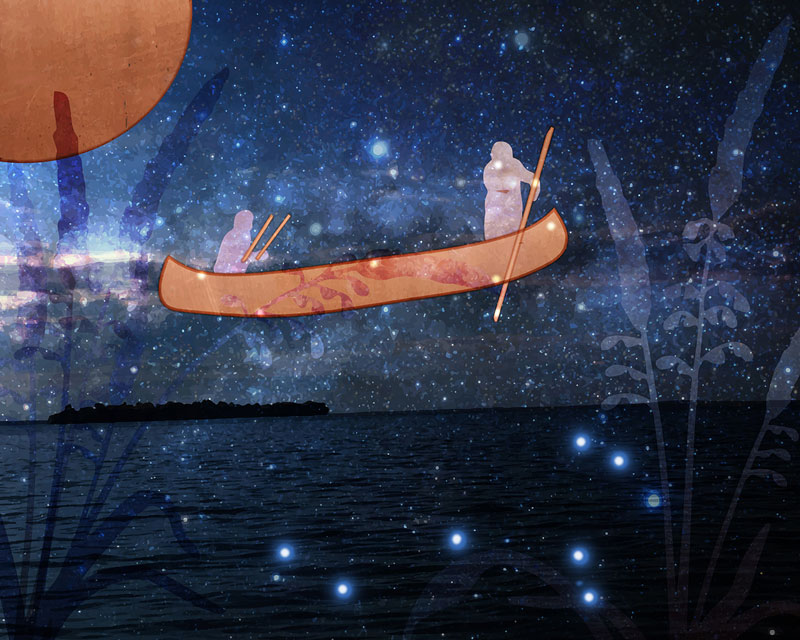Manoominike Mazina'anang
the Wild Ricing Constellation

Original artwork by Elizabeth LaPensée
In 2010, a story came to me in my dreams about two young Ojibwe men who died while harvesting our sacred wild rice. This dream came to me after a conversation I had with a highly respected Ojibwe elder from the Leech Lake Reservation in Minnesota who has harvested rice all of his life. This elder told me about an actual incident where two young Ojibwe men capsized while hauling a canoe full of wild rice over open water to the boat landing. The waters just off Sugar Point, where the incident happened, are deep and dark. At that particular location, the westerly winds and waves on Leech Lake can be fierce.
That autumn, I was conducting a scientific study on wild rice beds in the northern half of Leech Lake. By using a hand-held GPS unit and a kayak, I paddled out onto the lake and gathered point data on the rice beds just off Sugar Point. While I was collecting data, I could faintly hear drumming and singing echoing across the immense lake. Coincidentally, the Sugar Point Traditional powwow was in full swing and many people were attending that day. For me, it was a surreal experience to be out on the water alone that evening listening to those traditional songs. The next day, I ventured to the Town of Cass Lake to visit with this elder and long-time friend about that year's wild rice harvest, and it was during that visit that he told me the fateful story.
That following winter, I dreamt of those young men who perished in the waters of Leech Lake, and in that dream, the two young men and their canoe were lifted into the night sky toward the Jiibekana, the Pathway of Souls, also known as the Milky Way. In the Anishinaabe language, Jiibekana is the celestial passage to the Spirit World and it extends the length of the night sky. Jiibayag Niimi'idiwag, "The Spirits Are Dancing," are what the Anishinaabe people call the Northern Lights, and they are believed to be the reflections of campfires in the Spirit World where our ancestors reside. These cosmological terms in the Anishinaabe language begin to describe an afterlife according to the Anishinaabe worldview.
The next evening, with this dream fresh in my mind, I went out to gaze up into the night sky looking for Jiibekana. Suddenly, the image of those young men and their canoe jumped out at me in the stars. A cluster of bright stars perfectly outlined the canoe and the young men. I could see the canoe moving through the wild rice with the poler standing in front of the canoe. This practice, with the poler standing in front, is an old tradition that very few harvesters use today. By standing in the front of the canoe, the poler pushes the canoe through the rice stand, while the knocker sits in the back knocking the ripened grains into the boat. This method balances the weight in the canoe and provides more stability, especially if the canoe is tippy.
Over the next year, I watched this cluster of stars revolve in a circular motion around Giiwedanang (Returning Home Star), which most people know as the North Star. During Manoominike-giizis (the Moon of the Wild Rice Harvest), which is also the month of August, this star cluster sits just east of Giiwedanang in the early evening and, like all other stars in the night sky, makes its way around it in a counterclockwise direction. This star cluster never sinks below the horizon as it revolves and can be seen throughout the year; this circular area of the night sky is known as the circumpolar region. Most people who are familiar with western astronomy know this constellation as Cassiopeia. If you look closely at this star formation, you will see numerous stars outlining the canoe and one bright star that represents the poler pushing the canoe through the stands of wild rice. The canoe slowly moves in a forward direction and can be seen in different regions of the sky throughout the year.
Another intriguing aspect of this particular star cluster is that the canoe is located in Jiibekana, the Pathway of Souls, and serves as a constant reminder of the young Ojibwe men's journey to the Spirit World.
When I first told this story, the wild rice harvest season has just begun in Minnesota, Wisconsin and parts of Michigan. I believe this constellation tells a story of the potential risks involved in harvesting wild rice on open lakes and reminds people of the importance of maintaining the sacred traditions of survivance given to us by our Anishinaabe ancestors. The name that came to me for this constellation is Manoominike mazina'anang – the Wild Ricing Star Constellation.
- Mii'iw (That is all)